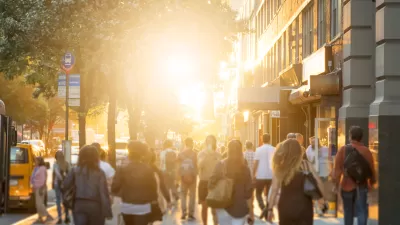Angie Schmitt looks at the greenwash being applied to new sprawl developments in Ohio, Indiana, and Texas as developers market to consumer preferences for more walkable urban environments.
On Schmitt's radar are The Lakes of Orange, outside Cleveland ("Ohio's FIRST Green Certified Residential Community"), Saxony, outside Indianapolis, and The Bridgelands, far outside of Houston, which make varying dubious environmental claims in their marketing materials in order to respond to changing tastes.
Although "many of these new housing developments - to be fair - are real improvements over their 1990s counterparts," Schmitt looks beyond the greenwash to see that "any environmental savings these developments produce will likely be eclipsed by their near-total dependence on auto travel, which accounts for almost a third of Americans' energy use."
"The Lakes of Orange is on the undeveloped periphery of Cleveland - a shrinking city surrounded by a shrinking metro area. Literally 30,000 vacant homes that are already served by sewer, roads and water, sit closer to retail and work, accessible to the region's transit system."
While LEED-ND is intended to encourage more sustainable development patterns by awarding points for infill development and rehabbing existing buildings, only four or five projects have achieved certification.
"So when will we see a new 'Lakes of Orange' or ‘The Bridgelands' in a sustainable location with multiple transportation options and a LEED-ND seal? And when will that become the norm, not the exception? It's going to take a rethinking of the financial and regulatory incentives that favor sprawl, as well as increased awareness of what makes development truly sustainable - and that includes location efficiency, not just green roofs and compact fluorescent lightbulbs," concludes Schmitt.
FULL STORY: The Greenwashing of Sprawl

Planetizen Federal Action Tracker
A weekly monitor of how Trump’s orders and actions are impacting planners and planning in America.

Map: Where Senate Republicans Want to Sell Your Public Lands
For public land advocates, the Senate Republicans’ proposal to sell millions of acres of public land in the West is “the biggest fight of their careers.”

Restaurant Patios Were a Pandemic Win — Why Were They so Hard to Keep?
Social distancing requirements and changes in travel patterns prompted cities to pilot new uses for street and sidewalk space. Then it got complicated.

Platform Pilsner: Vancouver Transit Agency Releases... a Beer?
TransLink will receive a portion of every sale of the four-pack.

Toronto Weighs Cheaper Transit, Parking Hikes for Major Events
Special event rates would take effect during large festivals, sports games and concerts to ‘discourage driving, manage congestion and free up space for transit.”

Berlin to Consider Car-Free Zone Larger Than Manhattan
The area bound by the 22-mile Ringbahn would still allow 12 uses of a private automobile per year per person, and several other exemptions.
Urban Design for Planners 1: Software Tools
This six-course series explores essential urban design concepts using open source software and equips planners with the tools they need to participate fully in the urban design process.
Planning for Universal Design
Learn the tools for implementing Universal Design in planning regulations.
Heyer Gruel & Associates PA
JM Goldson LLC
Custer County Colorado
City of Camden Redevelopment Agency
City of Astoria
Transportation Research & Education Center (TREC) at Portland State University
Camden Redevelopment Agency
City of Claremont
Municipality of Princeton (NJ)





























